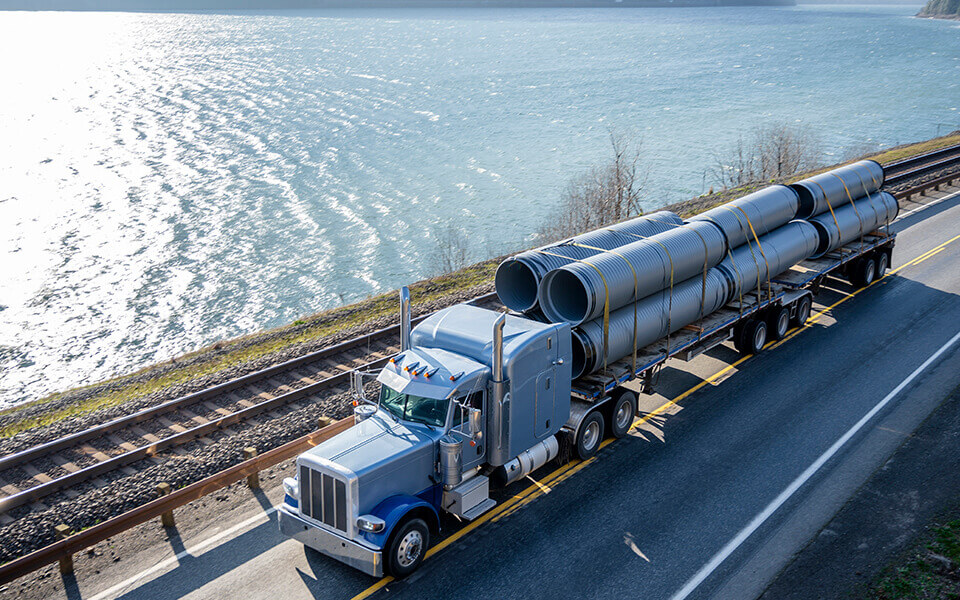Flatbed Trucking: The Unsung Workhorse of American Industry
Let’s be real—while dry vans get all the glory hauling Amazon boxes, flatbeds are out here moving the literal backbone of our economy. These aren’t your average trailers; they’re the heavy-duty platforms hauling everything from wind turbine blades longer than football fields to million-pound industrial equipment.
If dry vans are the minivans of trucking, flatbeds are the industrial cranes on wheels—no walls, no roofs, just pure hauling muscle. Here’s why they matter more than you think.
What Makes Flatbeds Different? (It’s Not Just the Lack of Walls)
Flatbeds are the Swiss Army knives of freight:
✔ No height restrictions – Haul towers, silos, and oversized machinery
✔ Open loading access – Load from the sides, top, or even with cranes
✔ Weight capacity – Some can handle 200,000+ lbs with permits
*”Try fitting a 40-foot steel beam into a dry van. Go ahead—I’ll wait.”* —Flatbed driver, probably
What Flatbeds Haul (The Cool Stuff You Never Notice)
1. The Renewable Energy Revolution
- Wind turbine blades (Up to 300 feet long—yes, really)
- Solar panel racks (Thousands of pounds of aluminum)
- Hydroelectric parts (Giant turbines that power cities)
Fun fact: A single wind farm project can keep dozens of flatbeds busy for months.
2. Construction’s Lifeline
- I-beams (The skeleton of every skyscraper)
- Crane parts (Because cranes can’t build themselves)
- Precast concrete (Entire walls shipped ready to install)
“We delivered the supports for a new bridge—each piece weighed 80,000 lbs. One wrong move and boom.” —Seasoned flatbedder
3. Manufacturing’s Heavy Hitters
- Industrial presses (The machines that build your cars)
- Oilfield equipment (Drilling rigs that weigh as much as whales)
- Farm machinery (Tractors that cost more than houses)
The Dark Arts of Flatbed Securement
Loading a flatbed isn’t just “throw it on and go.” It’s an engineering challenge:
The Tools of the Trade:
⛓️ Chains & binders – Rated for 10,000+ lbs each
🛡️ Rubber mats – Prevent steel-on-steel sliding
📏 Load bars – Keep heavy equipment from shifting
The Rules:
- DOT requires 1 chain for every 10,000 lbs
- Everything must be secured to withstand 0.5G forces (That’s like slamming on the brakes at 50 mph)
- Tarping is mandatory for many loads (Ever tried folding a 40’ tarp in the wind?)
*”I spent 3 hours securing a 60,000-lb generator. DOT inspected it and said ‘Nice work.’ Best compliment of my career.”*
Why Flatbed Drivers Are a Different Breed
These aren’t your average “drop and hook” truckers. Flatbedding requires:
💪 Physical toughness – Climbing loads in blizzards to secure them
🧠 Engineering smarts – Calculating load distribution on the fly
😤 Patience of saints – Waiting 6+ hours at shippers who “aren’t ready”
“You haven’t lived until you’ve tarped a load in a Kansas thunderstorm.”
The Money Side: Why Flatbed Pays (But Earns It)
Rates:
- 3.50−3.50−6.00/mile (vs. 2.00−2.00−3.00 for dry vans)
- Oversize loads pay premiums (Up to $10/mile for extreme widths)
But You Earn Every Penny:
- 1-3 hours loading/unloading per stop (No quick dock bumps)
- Permit paperwork (Some states require 7+ permits for one load)
- Pilot car costs (For super-wide loads)
Flatbed’s Dirty Little Secrets
1. The “We Don’t Have a Forklift” Scam
Some shippers “forget” to mention you’ll need to:
- Wait 4 hours for equipment to arrive
- Unload it yourself with a come-along (true story)
2. Bridge Law Surprises
Each state has different rules for:
- Maximum weights per axle
- Time-of-day travel restrictions
- Escort requirements
“Got fined $800 in Ohio because my spread axle was 2 inches too close. Learned the hard way.”
3. Weather Roulette
- Rain? Now your steel coils are slipping hazards
- Wind? Say goodbye to your tarp (and possibly your load)
- Ice? Have fun chaining up on the shoulder
How Shippers Can Be Flatbed Heroes
Want your freight moved fast and damage-free? Help your drivers:
✅ Have loading equipment READY
✅ Provide accurate weights/dimensions
✅ Offer a tarp shed (Not all of us enjoy wrestling tarps in rain)
✅ Pay detention after 2 hours (We’re not park benches)
The Future of Flatbeds
- Self-securing chains (In development)
- Electric flatbeds (For local heavy haul)
- AI load planning (To prevent “oops, too heavy on one side”)
Bottom Line
Next time you see a flatbed hauling:
- A bridge section over your highway
- A wind turbine blade longer than a Boeing 747
- A 250,000-lb transformer moving at 35 mph
Remember: That driver spent hours securing it perfectly so it doesn’t end up on the nightly news.
Thinking about flatbedding? I’ve got a list of carriers who treat drivers right—hit me up.

